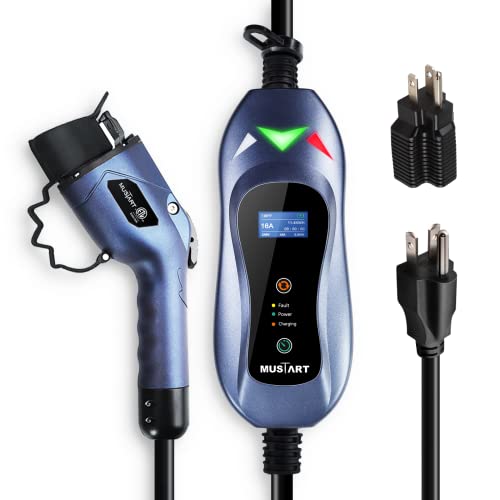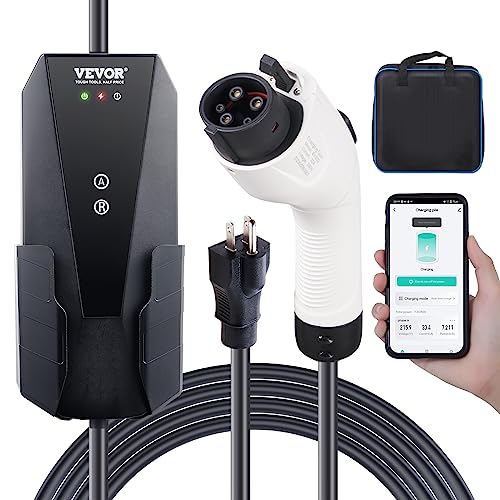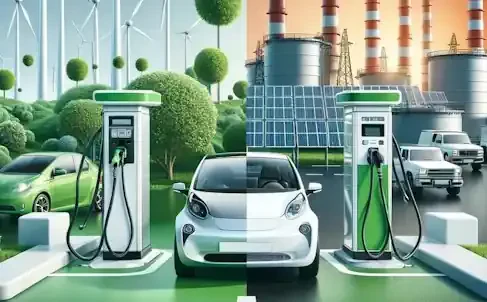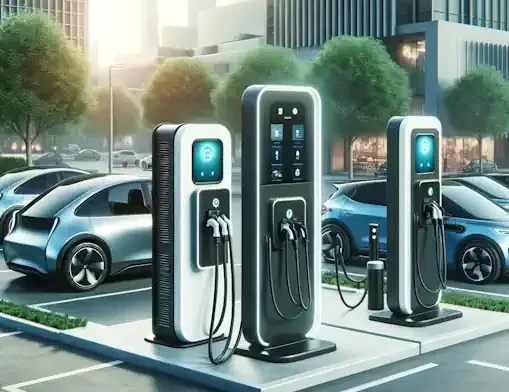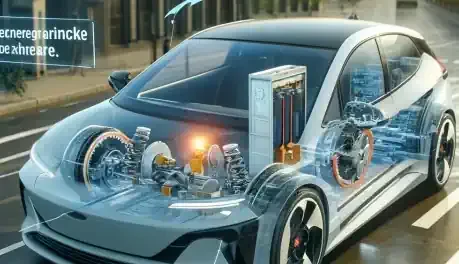The Rise of Electric Vehicles (EVs) and the Importance of Home Charging Infrastructure
In recent years, the automotive industry has witnessed a remarkable shift towards electric vehicles (EVs) driven by a growing awareness of environmental sustainability and advancements in battery technology. As governments worldwide enact stricter emissions regulations and consumers increasingly prioritize eco-friendly transportation options, the adoption of EVs has surged.
Central to the success and widespread adoption of electric vehicles is the establishment of robust home charging infrastructure. Unlike conventional internal combustion engine vehicles, EVs rely on electric power stored in onboard batteries, necessitating regular recharging. Home charging solutions provide EV owners with the convenience and accessibility of recharging their vehicles overnight or during downtime, eliminating the need for frequent visits to public charging stations and ensuring that the vehicle is ready for daily use.
Amidst the rapid proliferation of electric vehicles, navigating the landscape of electric car chargers can be daunting for both prospective and current EV owners. Recognizing this need for clarity and guidance, this article aims to serve as a comprehensive resource for understanding electric car chargers tailored specifically for home use. From the different types of chargers available to factors to consider when selecting one for your home, this guide seeks to empower readers with the knowledge necessary to make informed decisions about their home charging setup. Whether you're a newcomer to the world of electric vehicles or a seasoned enthusiast looking to optimize your charging experience, this article will equip you with the insights and expertise needed to effectively navigate the realm of electric car chargers.
Understanding Electric Car Chargers
As the popularity of electric vehicles (EVs) continues to soar, understanding the intricacies of electric car chargers becomes crucial for both seasoned enthusiasts and newcomers alike. Let's delve into the world of electric car chargers to demystify their types, charging speeds, and factors to consider when selecting one for home use.
Explanation of Different Types of Electric Car Chargers
Level 1 Chargers
Level 1 chargers are the most basic option, typically included with the purchase of an electric vehicle. They use a standard household outlet (120 volts) and are best suited for overnight charging. While convenient for topping up the battery slowly, they are not ideal for quick recharges.
Level 2 Chargers
Level 2 chargers operate at higher power levels (240 volts) compared to Level 1 chargers, enabling faster charging times. These chargers are commonly installed at home or in public charging stations. They offer significant convenience, particularly for daily charging needs, as they can fully replenish an EV's battery overnight or within a few hours.
DC Fast Chargers
DC fast chargers, also known as Level 3 chargers, are designed for rapid charging on the go. Unlike Level 1 and Level 2 chargers, DC fast chargers bypass the vehicle's onboard charger and deliver direct current (DC) power to the battery, allowing for much faster charging times. They are commonly found along highways and in urban areas, catering to drivers in need of quick recharges during long trips.
Comparison of Charging Speeds
, Capabilities, and Compatibility with Different EV Models
Charging Speeds: Level 1 chargers typically offer the slowest charging speeds, followed by Level 2 chargers, and then DC fast chargers, which provide the fastest charging rates.
Capabilities: While Level 1 and Level 2 chargers are suitable for most daily charging needs, DC fast chargers are indispensable for long-distance travel, offering the ability to recharge an EV to 80% capacity in a matter of minutes.
Compatibility: Most ele
ctric vehicles are compatible with Level 1 and Level 2 chargers, but not all models support DC fast charging. It's essential for EV owners to check their vehicle's specifications to ensure compatibility with different charger types.
Factors to Consider When Selecting a Charger for Home Use
Power Output: Consider the power output of the charger, as it directly influences charging speed. Higher power output chargers, such as Level 2 chargers, can significantly reduce charging times compared to Level 1 chargers.
Connector Type: Ensure compatibility between the charger's connector type and your EV's charging port. Common connector types include SAE J1772 for Level 1 and Level 2 chargers, and CCS (Combined Charging System) or CHAdeMO for DC fast chargers.
Smart Features and Connectivity Options: Look for chargers with smart features such as scheduling, remote monitoring, and connectivity with mobile apps. These features enhance convenience and allow for better integration with smart home systems.
Understanding the nuances of electric car chargers is essential for optimizing the charging experience and maximizing the efficiency of electric vehicles. By considering the types, capabilities, and factors outlined above, EV owners can make informed decisions when selecting chargers for home use, ensuring seamless integration into their daily routines.
Installing an Electric Car Charger at Home
Overview of Installation Process
Assessing Electrical Capacity and Compatibility
Before installing an electric car charger at home, it's essential to evaluate your electrical system's capacity and compatibility with the charger. Determine whether your electrical panel has sufficient capacity to accommodate the charger without overloading the circuit. Additionally, ensure that your home's wiring and electrical infrastructure meet the requirements specified by the charger manufacturer.
Obtaining Necessary Permits and Approvals
Installing an electric car charger typically requires obtaining permits and approvals from local authorities and building departments. These permits ensure that the installation complies with building codes and safety regulations. Be sure to check with your local municipality to understand the specific requirements and procedures for obtaining permits before proceeding with the installation.
Hiring a Qualified Electrician
Due to the complexity of electrical work involved in installing a car charger, it's crucial to hire a qualified electrician with experience in EV charger installations. A certified electrician can assess your electrical system, safely install the charger, and ensure compliance with local codes and regulations. Additionally, working with a professional electrician minimizes the risk of electrical hazards and ensures the longevity and reliability of the charging infrastructure.
Charger Placement and Location
Indoor vs. Outdoor Installation
When choosing the location for your electric car charger, consider whether to install it indoors or outdoors. Indoor installations offer protection from the elements and may be more convenient for daily charging. However, outdoor installations provide flexibility and accessibility, particularly for guests or multiple EV owners. Ultimately, the decision between indoor and outdoor installation depends on your specific needs and preferences.
Wall-Mounted vs. Pedestal Chargers
Electric car chargers are available in both wall-mounted and pedestal configurations. Wall-mounted chargers are mounted directly onto a wall, saving space and offering a sleek, integrated look. Pedestal chargers, on the other hand, are freestanding units that can be installed in various locations, providing flexibility in placement. Consider factors such as available space, aesthetic preferences, and ease of access when choosing between wall-mounted and pedestal chargers.
Accessibility and Convenience
Regardless of the installation location and charger type, prioritize accessibility and convenience when selecting the placement of your electric car charger. Choose a location that allows for easy access to the charger without obstructing pedestrian or vehicle traffic. Additionally, consider factors such as cable length, parking space availability, and proximity to the electrical panel to ensure a seamless charging experience for both you and other users.
By carefully considering the installation process and charger placement considerations outlined above, you can ensure a successful and efficient installation of an electric car charger at home, enabling convenient and reliable charging for your electric vehicle.
Costs and Incentives
Costs for Purchasing and Installing a Home EV Charger
When considering the installation of a home electric vehicle (EV) charger, it's essential to understand the breakdown of upfront costs involved. Here's a brief overview:
Charger Cost: The cost of the EV charger itself varies depending on the brand, model, and features. Basic Level 1 chargers are typically more affordable, ranging from $200 to $600, while Level 2 chargers, offering faster charging speeds, can cost anywhere from $500 to $1,500 or more.
Installation Cost: The installation cost includes labor charges for hiring a qualified electrician to install the charger and any additional materials required for wiring and mounting. Installation costs vary depending on factors such as the complexity of the installation, distance from the electrical panel, and local labor rates. On average, installation costs range from $500 to $1,500.
Permit Fees: Some municipalities may require permits for EV charger installations, which incur additional fees. Permit fees vary depending on the local regulations and may range from $50 to $200 or more.
Overall, the total upfront costs for purchasing and installing a home EV charger typically range from $750 to $3,000, depending on various factors such as charger type, installation complexity, and local requirements.
Overview of Potential Incentives and Rebates
Federal Tax Credits: The federal government offers a tax credit of up to $1,000 for the purchase and installation of qualified EV charging equipment at the taxpayer's primary residence. The credit is available through the Alternative Fuel Infrastructure Tax Credit and covers 30% of the total cost, including installation, up to the maximum credit amount.
State and Local Incentives: Many states and local governments offer incentives and rebates to encourage the adoption of electric vehicles and EV charging infrastructure. These incentives may include rebates for EV charger purchases, tax credits, grants, or discounted electricity rates for EV charging. The availability and amount of incentives vary by location, so it's essential to check with your state and local authorities for specific programs.
Utility Rebates and Programs: Some utility companies offer rebates, incentives, or special rate plans for EV owners to encourage off-peak charging and support the integration of EVs into the grid. These programs may include rebates for EV charger installations, time-of-use electricity rates, or discounts on electricity usage during off-peak hours. Check with your utility provider to explore available programs and incentives for EV owners.
By taking advantage of available incentives and rebates, EV owners can offset the upfront costs of purchasing and installing a home charger, making electric vehicle ownership more accessible and affordable while supporting sustainable transportation initiatives.
Maintenance and Troubleshooting
Maintenance Tasks to Ensure Optimal Charger Performance:
Cleaning and Inspection
Regular cleaning and inspection of your electric car charger are essential to ensure optimal performance and longevity. Keep the charger and its surroundings free from dirt, debris, and obstructions that could interfere with proper operation. Inspect the charger for any signs of damage or wear, such as frayed cables or loose connections, and address any issues promptly to prevent further damage.
Software Updates
Many electric car chargers come equipped with software that may require periodic updates to maintain compatibility with evolving technologies and standards. Check for firmware updates from the manufacturer and follow the instructions to ensure your charger has the latest software enhancements and bug fixes, which can improve performance and reliability.
Cable Management
Proper cable management is crucial for both safety and convenience. Routinely check the condition of the charging cable for any signs of wear or damage, such as kinks or exposed wires, and replace it if necessary. Avoid leaving cables exposed to harsh weather conditions or potential hazards, and use cable management accessories to organize and protect the cables from damage.
Common Issues and Troubleshooting Tips
Charging Errors and Faults
If you encounter charging errors or faults, first check the charger's display or indicator lights for any error codes or messages indicating the issue. Common causes of charging errors include faulty connections, incompatible charging cables, or issues with the vehicle's charging port. Try unplugging and re-plugging the charger, ensuring a secure connection, and if the issue persists, consult the charger's user manual or contact technical support for assistance.
Electrical Issues
Electrical issues such as tripped circuit breakers, power surges, or voltage fluctuations can disrupt charging operations. If your charger suddenly stops working or fails to initiate charging, check the electrical circuit breaker panel for any tripped breakers and reset them if necessary. Additionally, consider installing surge protection devices or dedicated electrical circuits to safeguard the charger from electrical disturbances.
Connectivity Problems
Connectivity problems, such as Wi-Fi or Bluetooth connectivity issues, can hinder remote monitoring and control features of smart chargers. Ensure that the charger is within range of your Wi-Fi network and that the network connection is stable. If experiencing connectivity issues, try power cycling the charger or resetting its network settings. If the problem persists, contact the manufacturer's technical support for further assistance.
By performing regular maintenance tasks and familiarizing yourself with common troubleshooting techniques, you can ensure the reliable operation of your electric car charger and minimize downtime, enabling seamless charging experiences for your electric vehicle.
Future Trends and Developments
Emerging Technologies in Home EV Charging
Vehicle-to-Grid Integration
Vehicle-to-grid (V2G) technology enables bidirectional communication between electric vehicles and the electrical grid, allowing EVs to not only draw power from the grid but also discharge stored energy back to the grid when needed. This innovative approach holds significant promise for balancing supply and demand on the grid, supporting renewable energy integration, and providing grid stabilization services. With V2G integration, EV owners can potentially earn revenue by participating in demand response programs or selling excess energy back to the grid during peak demand periods.
Wireless Charging
Wireless charging technology eliminates the need for physical cables and connectors by transferring power wirelessly from a charging pad embedded in the ground or mounted on a surface to a receiver coil installed on the underside of the vehicle. While still in its early stages, wireless charging offers convenience and ease of use, enabling automatic charging without the hassle of plugging in cables. As this technology matures, it has the potential to revolutionize the EV charging experience, particularly for autonomous vehicles and fleet applications.
Advanced Smart Charging Algorithms
Advanced smart charging algorithms leverage artificial intelligence (AI) and machine learning techniques to optimize charging schedules, minimize energy costs, and reduce grid congestion. These algorithms analyze various factors such as energy prices, grid capacity, and user preferences to dynamically adjust charging rates and schedules, ensuring efficient use of resources and maximizing the benefits of EV charging for both consumers and grid operators. By intelligently managing charging loads and coordinating with renewable energy sources, smart charging algorithms can help mitigate the impact of EV charging on the grid and accelerate the transition to a sustainable energy future.
Potential Impacts of EV Adoption on Residential Energy Consumption and Grid Infrastructure
As electric vehicle adoption continues to grow, it is expected to have significant implications for residential energy consumption and grid infrastructure. While EVs offer environmental benefits and reduced dependence on fossil fuels, their widespread adoption poses challenges related to grid capacity, load management, and infrastructure investment. Key potential impacts include:
Increased Residential Energy Demand: The proliferation of electric vehicles will lead to an increase in residential energy demand, particularly during peak charging periods. This heightened demand may strain local distribution networks and necessitate upgrades to grid infrastructure to accommodate higher loads.
Grid Congestion and Peak Demand Management: Concentrated charging of electric vehicles during peak hours could exacerbate grid congestion and peak demand challenges. Implementing smart charging solutions, time-of-use pricing, and demand response programs can help mitigate these issues by incentivizing off-peak charging and optimizing load distribution.
Opportunities for Grid Integration and Demand-Side Management: Electric vehicles present opportunities for grid integration and demand-side management initiatives. Vehicle-to-grid (V2G) technology enables EVs to serve as distributed energy resources, providing grid services such as load balancing, peak shaving, and energy storage. By leveraging EV batteries for grid support, utilities can enhance grid reliability, integrate renewable energy sources, and reduce greenhouse gas emissions.
In conclusion, emerging technologies in home EV charging, such as vehicle-to-grid integration, wireless charging, and advanced smart charging algorithms, hold promise for transforming the electric vehicle charging landscape and facilitating the transition to a cleaner, more sustainable energy future. However, addressing the potential impacts of EV adoption on residential energy consumption and grid infrastructure will require coordinated efforts from policymakers, utilities, automakers, and consumers to ensure a smooth and equitable transition to electrified transportation.
Conclusion - Guide to EV Chargers for the Home
Throughout this article, we have explored various aspects of electric car chargers for home use, delving into topics such as understanding different charger types, installation processes, costs, maintenance, troubleshooting, and future trends. We discussed the importance of assessing electrical capacity, obtaining necessary permits, and hiring qualified electricians for charger installations. Additionally, we highlighted considerations for charger placement, common maintenance tasks, troubleshooting tips, and emerging technologies shaping the future of home EV charging.
Importance of Home Charging Infrastructure for the Widespread Adoption of Electric Vehicles
Home charging infrastructure plays a pivotal role in facilitating the widespread adoption of electric vehicles. By providing EV owners with convenient and accessible charging solutions, home chargers eliminate the reliance on public charging stations and ensure that vehicles are consistently charged and ready for use. Moreover, home charging infrastructure enables EV owners to take advantage of off-peak electricity rates, optimize charging schedules, and contribute to grid stability and renewable energy integration. As electric vehicles become increasingly prevalent, investing in home charging infrastructure is crucial for supporting sustainable transportation and reducing greenhouse gas emissions.
Explore the Options and Take Advantage of Incentives to Install a Home EV Charger:
As we move towards a cleaner and more sustainable transportation future, we encourage readers to explore their options and consider installing a home electric vehicle charger. With a wide range of charger types, incentives, and emerging technologies available, there are ample opportunities to customize your charging setup to suit your needs and preferences. Whether you're a current EV owner or considering purchasing an electric vehicle in the future, installing a home charger offers convenience, cost savings, and environmental benefits. Furthermore, taking advantage of incentives such as federal tax credits, state and local incentives, and utility rebates can help offset upfront costs and make home EV charging more accessible and affordable. By investing in home charging infrastructure, you can contribute to the transition to electric transportation and pave the way for a cleaner, greener future for generations to come.

